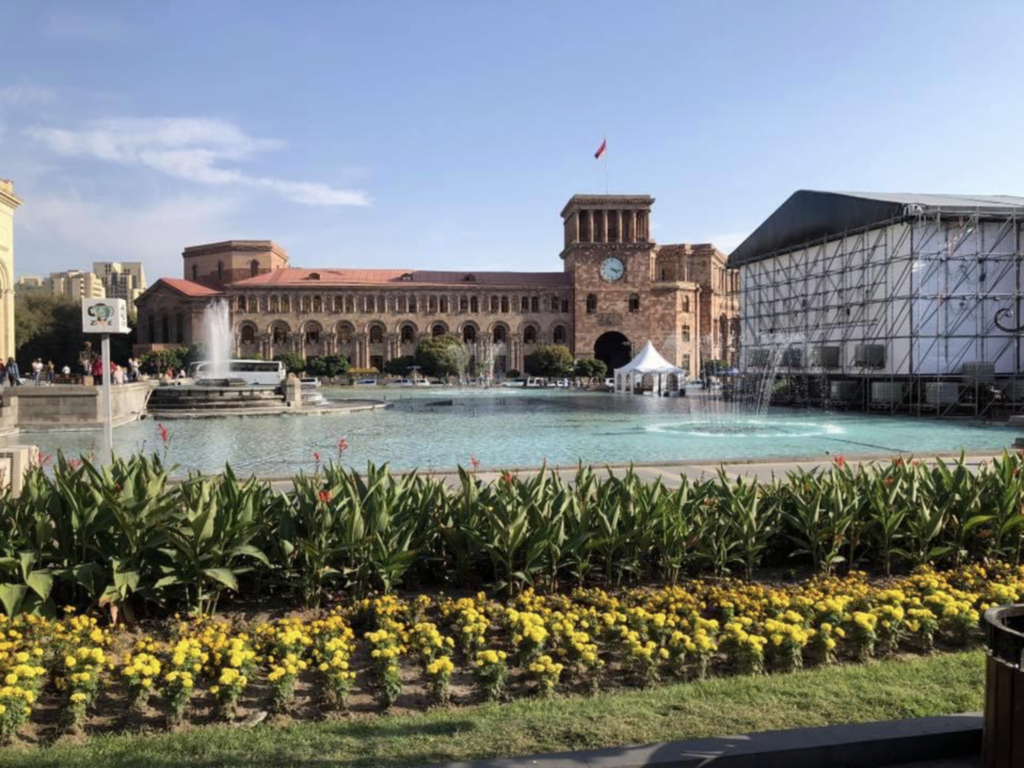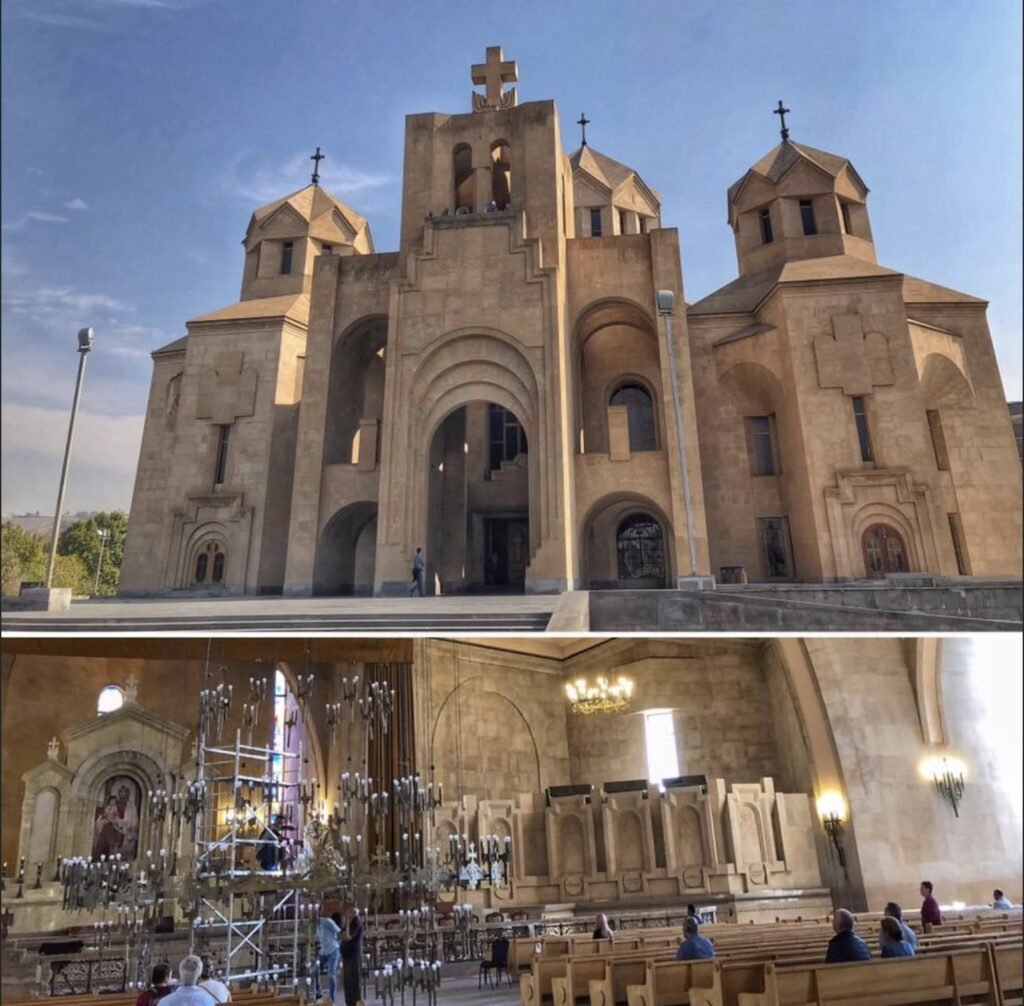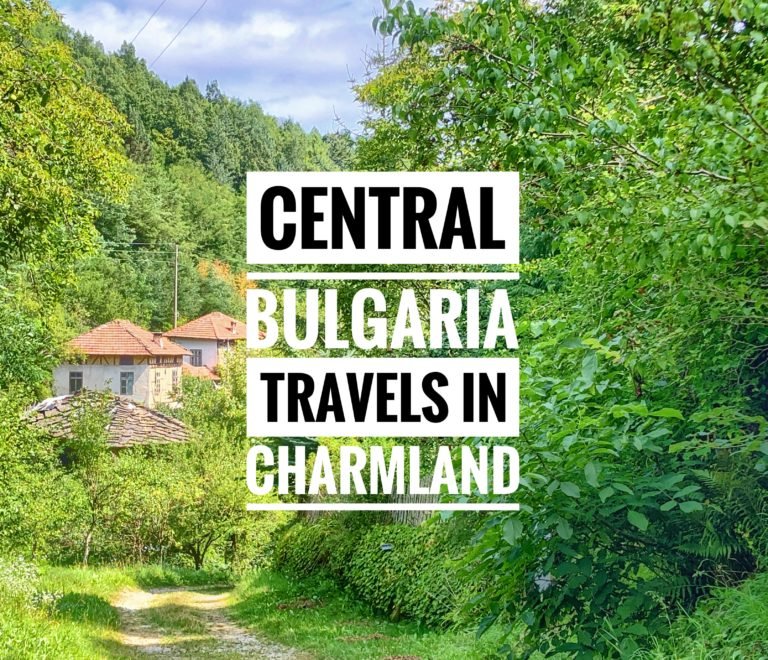
Mt. Ararat looms over the city of Yerevan at 5,137 m. (16,854 ft). Ararat, now in Turkey, is notable as the mountain on which Noah’s Ark landed upon, and according the Bible, the remains rest there under its snow-capped peak. Armenians consider Ararat the symbol of their state no matter where the mountain lies . There is a giant statue in Yerevan called the “Mother of Armenia” with a giant sword in her hand. Not coincidentally she faces Turkey.

Like arriving in Alaverdi, arriving in Yerevan was a bit…confusing. The taxi driver could not find our place so he dropped us off at a supermarket nearby. Once we thought we may have gotten to our street, there was no signage to confirm. Fortunately, a local (or a helpful government official), had tagged this wall with the street name to help out. Hopefully signage is something they’re working on 😉

We were elated to have a truly huge flat all to ourselves during our time in Yerevan ($20/night). Big enough for us to spread out and have our own separate personal spaces, kinda nice since we’re spending 24/7 together these days 🙂 It also had a lovely terrace with some crafty DIY door-chairs and a patio overlooking the city and Mt. Ararat.

Speaking of that holy mountain, Armenia’s number one (unconfirmed) cigarette brand was named after it. Thoughts? They were 14 dram a pack ($.29). Not surprisingly for this price, everyone smokes here and you can still smoke in restaurants. We had never heard so many coughers on a flight than on ours out of Yerevan.

We were looking forward to seeing the oldest church in the world in Etchmiadzin, built in 301. For the record, this is not it. This is Saint Gayane Church, on the UNESCO heritage list, The second (of three!) UNESCO listed churches in Vagharshpat, Armenia but was “only” built in 630, and was named after a martyred abbess, who was killed on this site around 301 just prior to the transition of Armenia to be the first Christian state in the world. The three-domed basilica has remained pretty much unchanged other than a few renovations in the 1600’s.

The fresco over the entrance to Saint Gayene Church

A priest escorted us behind the altar, and into the depths of Saint Gayane under the floor to reveal a hidden tomb. In it, a memorial to Saint Gayane

This scaffold-laden building is actually the oldest church in the world—Etchmiadzin, built in the year 301. It’s pretty understandable that a 1700-year old building would need a facelift, but what a bummer to have this going on for our visit. The church was built by King Trdat III and St Gregory the Illuminator, following the adoption of Christianity as the first state religion. Armenia is one of the few countries in the world where Christianity is significantly increasing, particularly among young women.

Peeking under the scaffolding to the beautifully intricate entrance to Etchmiadzin cathedral.

Unfortunately, glancing inside we found the entire interior was also covered in plastic sheeting and floor to ceiling scaffolding for renovation. A fresco of St. Gregory is on the left.

This modern church is at the entrance to the Etchmiadzin complex, The complex housing both is commonly known as “Armenia’s Vatican City.”

The cemetery near Saint Gayane church…none of the tombstones were marked other than a few dates, but the well worn stone coffins told us they were quite old.

After Etchmiadzin, it was beer o’ clock, so we decided to visit Dargett Craft Brewery, one of two(?) craft breweries in Yerevan with some damn fine beer for this region. It’s notable as being featured on Anthony Bourdain’s last episode of “Parts Unknown.” Gosh, we miss that guy….

Gotta love how “feeling rich” due to conversion rates 😉 In fact, the 40,000 Armenian Dram is worth about $82 USD. Always makes for fun math when the exchange is $1/483.

The History Museum of Armenia was where we met for our free walking tour, and one which we also visited a couple days later. It had a fantastic collection of artifacts from this part of the world, including some man made tools from 15,000 BC and the world’s oldest pair of shoes… from 3,500 BC! Naturally we could not take pictures inside the museum or we would show you the historic Nike.

The Government of the Republic of Armenia building sits next to the Singing Fountain as a reminder of the lighter side of life as the officials gaze out the window. The Singing Fountain has Vegas-style light/water/music shows every evening, but we sadly missed this due to a huge event that was going on. Speaking of government, see the stage on the right? It’s for Francophonie 2018, the biggest international event to EVER to hit Armenia the weekend we were there! Despite the fact that Armenia only has about a 1% French speaking population, the 2018 La Francophonie Summit decided to based itself in Yerevan this year. It brought presidents, prime ministers, and heads of state from 84 countries. A very big deal for Yerevan!

We met up with our Free Walking Tour with Vako at the museum. Mandy and Vako had mutual connections through their time in Prague so it was good to see a “familiar” face in Armenia. Free walking tours are held in many major cities worldwide and it’s always a helpful and easy introduction to a new city. Just don’t forget to tip your guide! He did a fantastic job and we’d highly recommend!

The Armenian flag’s colors can be interpreted in different ways, but we learned that the red stands for the centuries of bloodshed throughout the country’s long history. The blue is for the blue Armenian sky (they get 300 days of sunshine) and the orange is actually apricot, the national emblem of Armenia which have been planted here for 3000 years and the Romans called the apricot “the Armenian apple.”

Traditional Armenian architectural-style. Despite the city’s Incredible 2800-year history, Yerevan is not bursting at the seams with ancient architecture, old town charm, or even an old town, although fortunately an effort is in progress to revive it. Being in a strategically important place, Yerevan has been leveled, razed, bulldozed, and rebuilt repeatedly due to natural disasters, and being at constant war with rival regional powers…Ottoman, Persian and Russian Empires. When they gained independence in 1918, Yerevan was a town of only 20,000 people. Fast forward to their centennial independence celebration and they’ve surpassed one million.

The remnants of a traditional Soviet cafe tucks itself near a Metro station entrance. Speaking of which, Yerevan did not get a metro until the ‘80s because due to Soviet rule, a city had to have a million people before it earned one. Compared to other European cities it is quite small with only 10 active stops.

As mentioned, Yerevan is known as “the Pink City” due to the tufa stone used on the facades of many of its buildings.

During our time in Armenia, the nation was in mourning of a great loss of Charles Aznavour who was a French-Armenian singer, lyricist and diplomat. The news on this was widespread throughout the country and also quite interesting timing with the Francophonie Festival bringing together the two nations.

The statues that surrounds Swan Lake (in the background) are very intriguing. This rather large-nosed one here is of Armenian composer Arno Babajanyan. Swan Lake is known most recently as the place where Kanye West jumped in after a recent free concert in Yerevan. This took place, of course during Kim Kardashian’s “famous” trip back to her homeland of Armenia. We also learned other famous Armenians include Cher and Andre Agassi.

The Cascade Complex is a beautiful open air museum with captivating modern art everywhere. From the top there are lovely views of the city and Mt Ararat.

The Yerevan metro only costs 100 Dram to ride (about $.25). You receive a one time use lighter-than-air plastic chip that looks like a leftover from Yerevan’s communist days, literally, to drop in the turnstile at the entrance. You buy your token from a ticket window. Ours was very kindly purchased for us by a young Armenian girl we had met in Alaverdi two days earlier whose parents had emigrated to the U.S., (Glendale, California of course.) In an amazing coincidence — Yerevan has over one million people — we happened to bump into again at the ticket window. She insisted on buying our fare for us. This kind of sincere and generous hospitality, we found out, is quite common in Armenia. Later, Mandy complimented a girl on her purple nail polish, her first response was, “Oh, I’m so sorry. If I had it with me I would give it to you!” It’s over-the-top kind, and totally unexpected gestures. Also, over-the-top is the hair on all these girls… seriously, the Armenian women all need to apply to be Pantene models.

In what seems another communist holdover, the woman in the booth at the bottom of the escalator, whose entire job seems to be ensuring that the escalator continues to function properly and efficiently at all times. By the way, don’t take her picture.

Some of the food we had in Yerevan, including the best tabouleh we’ve ever had at a Syrian restaurant. Also a delicious minced meat kebab, meat dumplings and cheesy potato soup. Yum!

Visiting the (over the top, in our opinion) Armenian megachurch of St. Gregory the Illuminator. It was built in 2001 for the 1700-year anniversary of when Armenia adopted Christianity. It holds, naturally, 1700 people.

And omg…the markets. The beautiful displays of dried fruits, nuts, seeds and produce was overwhelming. We decided to stock up on dried fruits for our upcoming hiking trip in Romania and ended up getting an entire bag of dried fruits and nuts for about $8. Important note: although pomegranates were readily available for super cheap in the market, they grow everywhere in Armenia, you can also pluck them off trees for free. Not missing paying $3 in the States for them!

If you sit down to any Armenian meal, it will undoubtedly have lavash bread on the table. Lavash is traditional Armenian thin bread that represents Armenia’s national cuisine and originates from Ancient Armenia. It is airy, thin and the perfect wrap for just about everything. It is so important to the history of Armenia that in fact, it made it on the UNESCO World Heritage Cultural List. Its preparation demands special skills and great effort, and always prepared by women. It is not a rule, but rather it is a tradition of the craft of lavash making that has been kept alive since ancient times. Similarly, we found that only men seem to drive taxis in Armenia… also from ancient times? 😉

Walking through the souvenir market Yerevan, we discovered some beautiful chess sets for sale. Did you know Armenia is the only country in the world where chess is a subject that is taught in school? Thus, every Armenian knows how to play. Not surprisingly, many very smart people are Armenian. They also sold some wicked kebab skewers at the market, Armenians take their kebab barbecues very seriously!

We then went to the Armenian Genocide Museum, an absolutely mandatory stop in Yerevan. It is here we truly learned (for the first time) the horrors that went on during the preceding massacres starting in 1899 up to the first Holocaust of the 20th Century, which happened in 1915 in what used to be the Armenian Kingdom.
According to the plaques, “In the Ottoman Empire, Muslims, the dominant group, deemed Armenians, along with other Christians and Jews to be “infidels” and relegated them to inferior status…they desired complete extermination. During the “cover” of WWI, the Ottoman Turks joined forces with Germany & Austria-Hungary and took 1.5 million lives through starvation, torture, forced labor and forced marches into the Syrian desert without water or food.“ It happened in four distinct phases: 1) the annihilation of Armenian soldiers of the Armenian Ottoman Army, 2) the destruction of the Western Armenian National Elite (aka killing all the smart people), 3) the deportation of civilians 4) concentration camps in Syria. The Armenians who fell victim to this horror endured a totality of misery and suffering unlike anything we can comprehend today.
We share these images because we believe people should know about what happened, but fair warning some photos and captions that follow are very graphic.

Survivors from the first massacres in 1899.

The horrors of what happened preceding the genocides: “Armenian children were tortured during the massacres. Their bodies were ripped off with sharp cotton hooks.”

Captioned Plaques from the museum read: “First the Armenian men were separated from the rest and stabbed to death. Women, children and the elderly were usually spared at the beginning. That quickly changed. In most locations along the route, armed local Turkish and Kurdish bands knew beforehand the exact arrival time of the caravans, raiding and killing helpless civilians. The police, as a rule, rather than preventing the attacks, encouraged and even got actively involved in them. The Kemmakh Gorge was the most infamous site of large scale massacres and the canyon turned into a gory slaughterhouse.
Torture techniques widely used included separating mothers from children, mutilation, horseshoeing human feet, bayoneting children, medical experiments, mass burning of live people, using pregnant women’s stomachs as target practice, amputation, and burying children alive.
Those who miraculously survived were driven farther south forced to march in the scorching sun through mountains and steppes, slowly starving to death. Children, girls and young women were kidnapped, raped and killed. Whoever overcame this were sent to concentration camps in Syrian and Mesopotamian deserts. Selecting the Deserts of Arabia as the destination was meant to wipe out for good whatever was left of the exiles.”

This map highlights the main deportation routes, killings and concentration/extermination camps.

This grim and rather gruesome lower photo documents the Young Turks actions. The Young Turks, pictured above, were the main perpetrators of the genocide. These officers returned to the site years later (1918) to “show off” their killings. Some German military officers who served in the Ottoman Empire at the time of the Armenian genocide and WWI, subsequently influenced, or informed, the formation of Adolf Hitler’s ideology.

And, this is exactly why we are speaking of it. Those who are ignorant allow history to repeat itself. We ALL, including our world leaders, need to be aware of dehumanizing others for their own pursuits.

One of the saddest parts of this story today is that this horrific genocide is not officially recognized as having ever happened by the Turkish government, and many other prominent governments (including the U.S.) in order to curry favor with Turkey diplomatically, even though the documentation and evidence that it indeed did happen is overwhelming and astounding. Due to this political gesturing and circumstance, this is likely why we were not taught about this genocide in school, although the WWII Holocaust is. Outside the museum is a large space where world leaders—presidents and prime ministers—and NGO’s plant trees to display recognition of the event. Here was one such plaque. We did not see one planted by any prominent government official from United States, although many smaller American-Armenian organizations or NGO’s were present.

Pictured is an eternal flame for the genocide, and an elderly woman placing flowers in remembrance.



